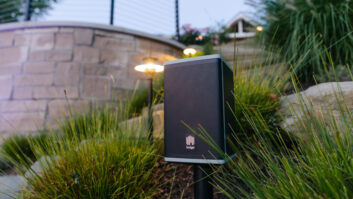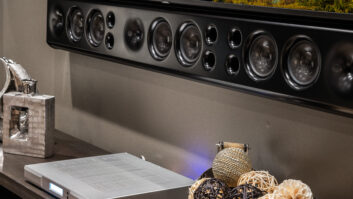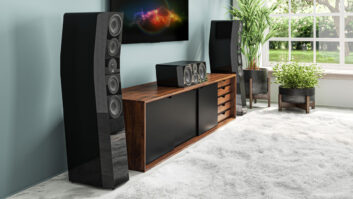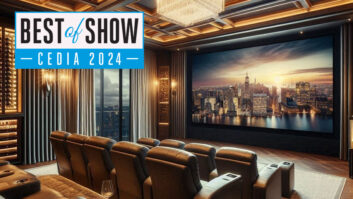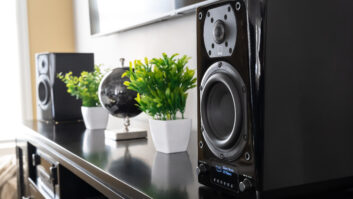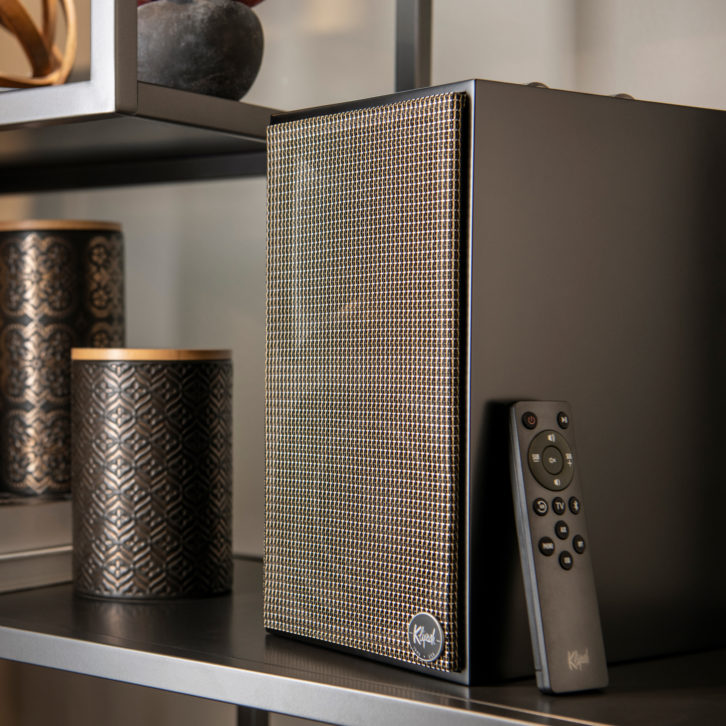
My first “stereo” was a JVC boombox that sat on a desktop in my room. Its primary playback source was a built-in cassette deck that saw near-constant play from whatever BMG “buy-seven-for-a-penny” deal I was working through that month, with an AUX input that eventually mated with a portable CD player. My favorite “feature” was that it had a 5-band spectrum analyzer.
However, it didn’t take too long before I realized I wanted more volume and performance than the boombox could offer, and from there I graduated to an actual “component system.” This meant moving from my simple, compact, all-in-one system to a whole stack of electronics that included a separate pre-amp, tuner, CD changer, graphic EQ, and amplifier. Over time I wired in my VHS Hi-Fi for improved movie and TV sound, as well as an NES for gaming.
But beyond a stack of gear (that, let’s be honest, 16-year-old me thought was pretty BA), it also added a lot of complexity and all kinds of wires that I really just guessed at connecting correctly. (The Tape 2 Monitor aspect of the EQ’s wiring was especially perplexing to my 16-year-old self.)
That was over 35 years ago, and, fortunately, the state of audio/video has definitely evolved (I doubt anyone is bemoaning the loss of that Tape 2 Monitor…), but if one of your customers came to you today wanting to enjoy quality audio in a secondary room, what would your solution be? Probably either adding a soundbar or creating some kind of rig around a stereo and speakers.
I get it, the soundbar is an easy play. I mean, there’s probably already a display in the room with sound that sucks and could desperately stand with improving, but, really, few soundbars are designed with music performance in mind. And, it’s tough to get any kind of appreciable stereo separation when your drivers are confined in a slim cabinet within 36 inches of each other. And while a receiver/speaker-combo has a ton of merit — allowing loads of flexibility to hit the customer’s desired performance, aesthetic, and budget level — it requires space the client might not want to give up.
For someone wanting great sound in the least complicated and smallest footprint possible, Klipsch is offering a perfect solution with its The Fives speaker package. With The Fives, you get a complete audio system in a package no larger than a pair of compact bookshelf speakers that places as much emphasis on music playback as improving TV audio, with facilities for incorporating just about any audio source.
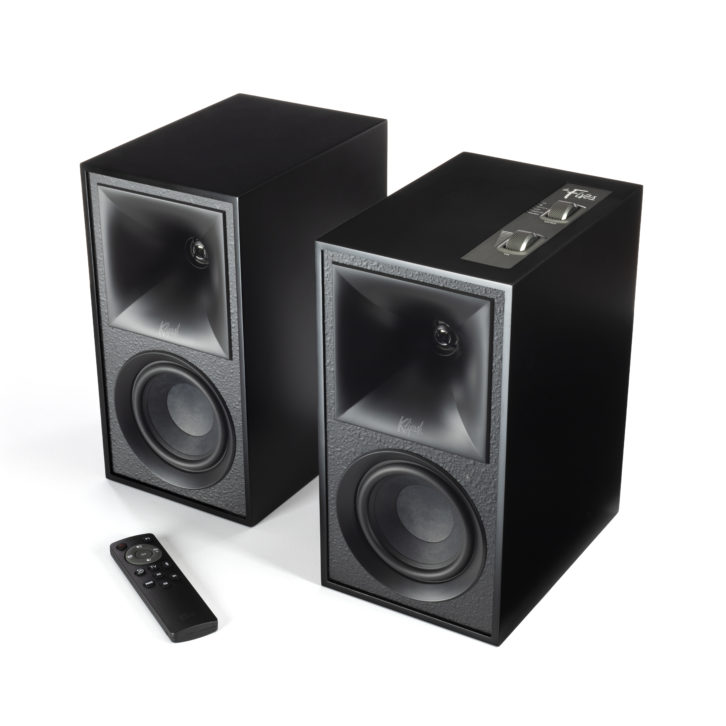
I first saw The Fives at CES in 2019, and they were one of those products I immediately felt compelled to walk over and touch. (I’m not sure if “knob feel” is an actual fetish, but, well, if you’ve ever felt the compulsion to go and turn the volume knob on a high-end piece of gear, then you’ll know what I’m talking about.) With a metallic insert on top of the primary speaker featuring two rotating wheels that control source and volume selection with white LED indicators, these knurled-metal dials have just the proper amount of heft and resistance to feel like part of a premium design, while giving them a wonderful analog vibe.
Even without listening to The Fives, it’s easy to grasp the solution Klipsch was looking to provide with them, and you’ll likely start to think of how they could fit into your bag of install tricks. Whether as a standalone 2-channel system, part of a house audio solution, or as an alternative to soundbars, The Fives are like a compact all-in-one Swiss Army knife audio solution. And, after you listen to them, well, you might start reconsidering that sub-$1000 receiver/speaker package idea as well.
Also reviewed by John Sciacca: LG SN11RG 7.1.4-Channel Dolby Atmos Soundbar
Installation
The Fives are handcrafted with real wood finishes, offered in either a matte black finish with a retro-looking silver-grey mesh grille (a bit reminiscent of an old Marshall amp stack) or in a light walnut-grain finish with a grey woven fabric grille (that, combined with its metal accents on top, gave me a bit of a cool steampunk vibe). A small round Klipsch badge roughly the size of a quarter sits fairly discreetly in the lower right-hand corner of the grilles, which are held on by magnets and are removable.
Heft is a good indicator of build quality when it comes to things like amplifiers, subwoofers, and speakers, and pulling The Fives out of the box with a combined weight of 22.5 pounds assures you they may be small, but they’re the real-deal. Giving the speaker’s cabinet a firm wrap with your knuckles produces a solid, dead thunk, further speaking to their build quality and that cabinet resonance will be minimal.
Standing 12 inches high by 6.5 inches wide and just 9.25 inches deep, the speakers’ head-on profile is about the size of a standard sheet of paper. This size keeps them small enough to work in a variety of locations and be fairly inobtrusive wherever they’re positioned. In fact, The Fives are small enough they could even work as a desktop system.
The size offers enough room for the primary speaker to house the electronics, amplification, and drivers, including a 4.5-inch high-excursion fiber-composite cone woofer and 1-inch Titanium tweeter with Klipsch’s Tractrix horn design for highly efficient and precise output. Bass output is augmented by a Tractrix port on the rear panel. While the driver diaphragms use a different material, The Fives draw from the same acoustic design and technology as Klipsch’s Reference Premiere series, featuring motor structures, phase plugs, and magnets from that line.
The underside of each speaker is finished with a cork-like material that not only gives them a lot of stability and resistance to sliding around, but it also ensures they won’t scratch or damage any cabinetry or furniture they are sitting on. I placed The Fives on speaker stands for all of my listening.
The Fives come with a well-written owner’s manual detailing the various connections, operations, Bluetooth pairing, and more. Amplification is housed in the primary speaker and includes 160 watts total system power (320 watts peak), divided into 60-watt x 2 for low-frequency drivers and 20-watt x 2 to the tweeters. The passive secondary speaker requires only connection to the primary via the included 15-foot speaker cable. (The speaker cable is not CL-rated for running in walls, but Klipsch offers a 10-foot extension cable if more length is needed.) I appreciated that the four-pin speaker cable connects securely by screwing into the back of each speaker, making a connection that could never become disconnected accidentally.
Since the primary speaker requires connection to power along with every external source, positioning it as the left or right in a system will likely depend on the layout of each install. Smartly, Klipsch includes a small L-R switch labeled “Primary” that lets you select whichever works best, which is just another sign that Klipsch really thought this design through. For me, I had the primary as left when listening at home, but as right when at work.
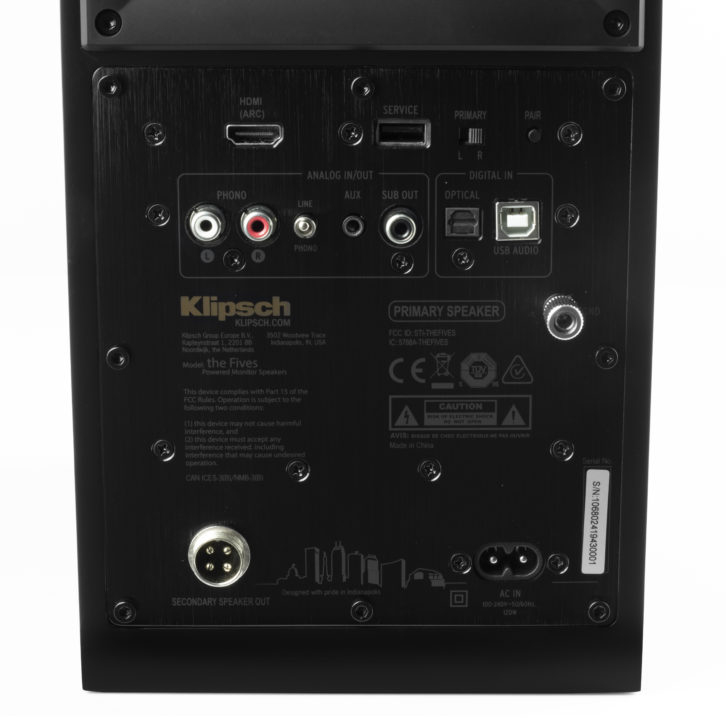
Checking out the back of the primary speaker, you’ll see it includes inputs accommodating nearly any source connection. There’s an HDMI connection with ARC for enjoying TV sound (TV audio output must be set to PCM for The Fives to work), an RCA input that accepts line-level or Phono signals, including ground (selectable via rear-panel switch), a 3.5mm mini-jack analog connection, a Toslink optical digital audio, and a USB Type-B connector for connecting to a computer. The speakers also include Bluetooth 5.0, supporting AptX-HD for the highest resolution Bluetooth audio. A built-in 192 kHz/24-bit DAC lets you send The Fives true high-resolution audio. A separate USB Type-A connector is labeled “Service” for firmware updates.
In the event The Fives don’t deliver enough bass output for your demands, an RCA subwoofer output is also provided. (This output is currently fixed at 80 Hz, though Klipsch commented they are looking at making this adjustable via a future firmware update.)
For listening, I connected a Sony TV via HDMI-ARC, a HEOS Link and Sonos Port via Toslink, a Marantz turntable via RCA, an LG Windows laptop via USB, and my iPhone 11 via Bluetooth.
Also reviewed by John Sciacca: Sony HT-G700 3.1-channel Dolby Atmos Soundbar
In Use
Speakers — even active ones — should basically just work; playing whatever you send their way with as little fuss between play-and-listen as possible. And, for the most part, that’s exactly what The Fives did. Most times they automatically kick on and switch over to the correct input when something begins playing, especially via the Optical or HDMI input. When they didn’t automatically trigger on, I’d just use the remote or speaker-mounted input selector. While the speaker mounted volume dial always functioned — smoothly rolling the LEDs up or down to indicate level — the source selector knob could be a little more sluggish when coming out of “sleep,” sometimes needing me to wheel the knob around for several seconds before it would start responding.
I ran The Fives through a gamut of music listening and always found them impressive. Sound was full, rich, and surprisingly room filling. Where they continually impressed over soundbar performance was in the width and soundstage. Where a soundbar’s audio is generally confined to roughly the width of the display (unless they are using some phasing trickery), The Fives give you true width and appreciable stereo. A perfect example was Hans Zimmer’s “Why So Serious?” from The Dark Knight, which has strings and percussion frequently bouncing back-and-forth between channels, an effect far more pronounced with The Fives. Further, during TV/movie viewing, when sounds were meant to appear far left/right, The Fives placed them appropriately way outside the screen.
The tweeters deliver detailed, open, and airy highs that I never found fatiguing even at louder volumes, which The Fives can produce in abundance. There is a really delicate, high-pitched chime note at about one minute into Holly Cole’s “Train Song” that The Fives were able to clearly produce.
Of special note is the bass output, which is truly prodigious for speakers of this size. While the frequency response is rated down to 50 Hz, I rarely felt I was missing out or needed a sub. Daria’s Strawberry Fields Forever is a jazzy, bossa-nova take on Beatles’ hits, and “Helter Skelter” opens with a big standing bass bassline that The Fives deliver with loads of texture and detail. One of my favorite bassy tracks is “High Roller” by The Crystal Method, and The Fives produced the tactile, big-bass notes you expect to hear.
The bass is so big, it is sometimes actually overpoweringly so, due to an EQ setting that Klipsch calls Dynamic Bass. This is supposed to boost bass at lower listening levels, but I found that, for some music listening, it gave the low-end a bit of a bloated feel, especially if the speakers were corner-loaded. Fortunately, you can disable this with EQ settings for Flat or Bass Cut.
I’m not a huge vinyl aficionado, but I know a lot of listeners are getting back to spinning albums — and the Phono input is one of The Fives unique twists — so I connected a Marantz TT42P at my showroom to check out operation. While listening to the two albums I had on hand, I noticed far more vinyl pops and clicks than I do when listening through our showroom’s regular setup, possibly due to the Marantz deck having a built-in phono pre-amp that was sending too “hot” a signal to The Fives. (Unfortunately, that was the only turntable I had access to.)
Granted, The Fives primary purpose is not playing TV audio, but rest assured this is a role they can definitely serve. Properly positioned, The Fives produce a solid “phantom” center channel that anchors dialog to the screen. Of course, the image collapses towards the left/right channel as you move off-center, but for couch-seated listening, I found The Fives did a great job with TV audio.
One of my big gripes with Bluetooth streaming is that I’ll invariably walk away with my phone in my pocket and the music will cut out. Not with The Fives, whose BT 5.0 implementation offered terrific performance and impressive range. In fact, a bit too impressive, as there were times when I was outside my house working with BT headphones on, and The Fives would randomly intercept the signal. But for easy streaming of music or a favorite podcast, The Fives’ BT implementation will serve you well.
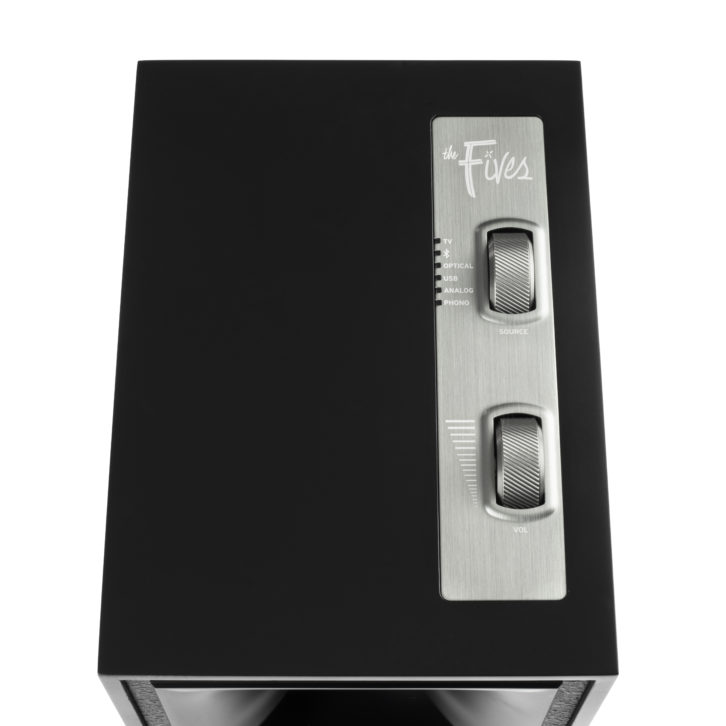
While I loved the look and design of the top-mounted controls, the indicators have practically zero value at any listening position. In practice this didn’t matter much; I mean, if I could hear them, I was on the correct input, and if I wanted it louder/quieter, I’d just adjust accordingly. But seeing if they were actually on or what EQ mode they were in required getting up and walking over to the speaker to check the indicator. On the plus side, the indicator lights were never distracting.
Klipsch has a “Connect App” that can be used with the speakers, but it is incredibly limited on what it can actually do. Short of registering your product, getting product info (MAC ID, serial number, model number, firmware version), and performing a firmware update, it didn’t seem to offer anything. It would be great if the app could give basic source selection and volume control functionality, as well as quickly toggling between the EQ modes, as I preferred Dynamic Bass on for video watching but off for most music listening. [Editor’s Note: According to Klipsch, EQ, remote control, and sound presets will be available in an app update in June.]
The Fives definitely present a new option for creating an affordable and simple 2-channel system that can fill a room with sound and not components. For music lovers, The Fives also offer a far better alternative to the confined soundstage of most soundbars, while still offering a way to improve TV sound. The only downside? The Five are currently only available through Klipsch direct and select specialty retailers, not via any of Klipsch’s usual CI distribution partners.
https://www.Klipsch.com; 800-544-1482
Kudos: Deep, tactile bass that greatly belies size; detailed, spacious highs; full-fledged system in simple, compact package
Concerns: Bass can be a bit overwhelming for music with Bass EQ engaged; no real app control
Price: $799/pair
Product Specs:
- Frequency response rated 50 Hz–25 kHz; 109 dB Max rated output; supports up to 192 kHz/24-bit high-resolution audio
- 5-inch high-excursion fiber-composite cone woofer with bass-reflex rear firing port; 1-inch Titanium vented tweeter with Tractrix horn
- 160 watts total system power (320 watts peak); 60-watt x 2 low-frequency, 20-watt x 2 high-frequency
- MDF enclosure with genuine wood veneer available in Black Matte or Walnut
- Bluetooth 5.0 wireless with AptX-HD
- Connections (Primary Speaker): Inputs — HDMI-ARC, RCA stereo analog audio (line level or Phono level), Ground, 3.5mm analog audio, Toslink optical, USB Type-B, USB Type-A (service); Outputs — RCA subwoofer, 4-pin connection to passive speaker, Power
Dimensions: 12 x 6.5 x 9.25 inches (HxWxD); Weight: 11.8/10.7-pounds (active/passive speaker)
